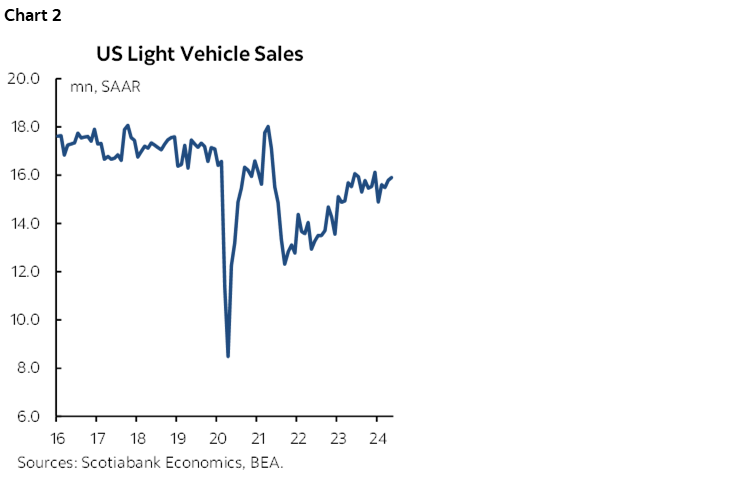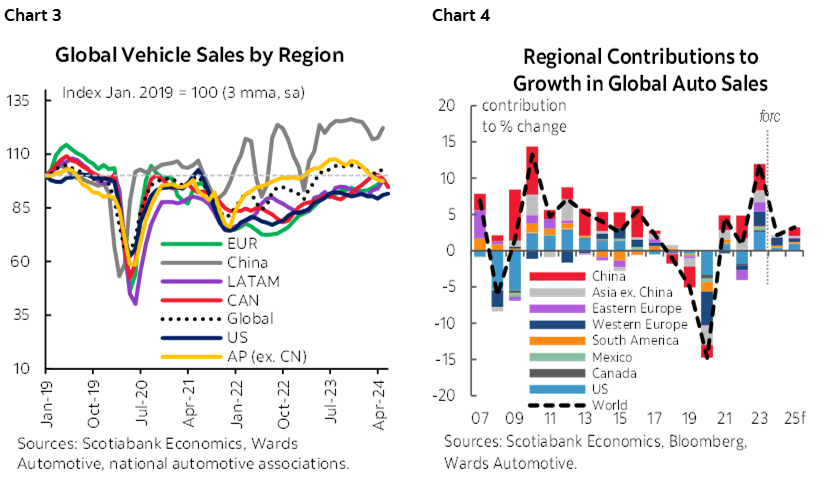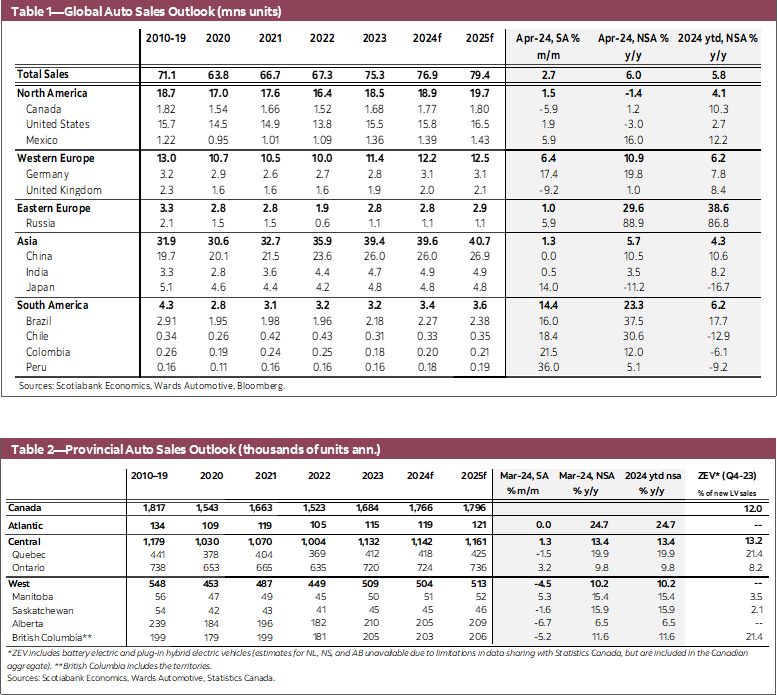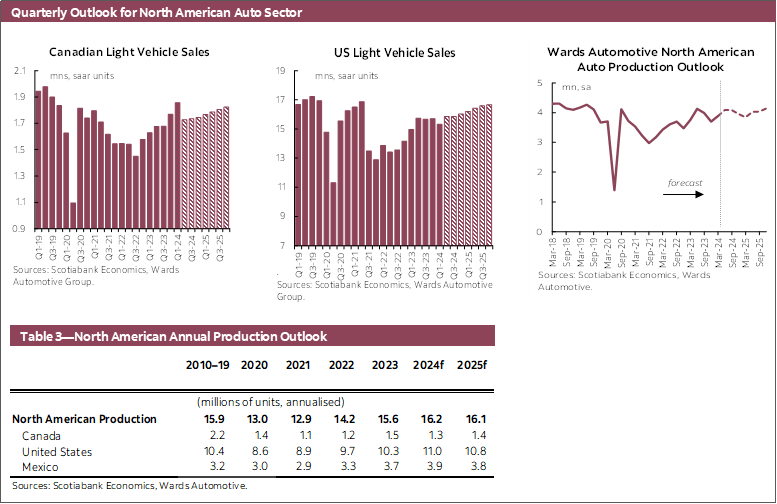CANADA: GROWTH IN AUTO SALES SLOWING, ANNUALIZED PACE STILL ABOVE 2023
Canadian auto sales slowed marginally in May (-0.2% m/m, SA) to 1.71 mn units at a seasonally adjusted annualized rate (SAAR) according to Wards Automotive (chart 1). This marks the third consecutive month of declining sales in seasonally adjusted terms, as the growth rate in auto sales continues to ease relative to the second half of 2023 and first two months of 2024. The slowing growth is not entirely due to potentially distorting seasonal adjustment factors, where Canadian auto sales usually pick up in the summer months and decline in the winter months. May’s non-seasonally adjusted sales were up only 0.3% year-over-year, well below the recent peak of 18.9% y/y in February. However, the pace of auto sales has averaged 1.8 mn (SAAR) units through the first five months of the year, above the 1.68 mn units sold in annual 2023 when sales had begun to recover from the pandemic-induced inventory and supply shortages. Growth in demand for new vehicles is likely to remain muted in the near term, as elevated interest rates weigh on consumer spending. The Bank of Canada cut its policy rate by 25 basis points to 4.75% at their June meeting last week, the first rate cut since they began raising rates in March 2022 which brought the policy rate from 0.25% to 5% by July 2023. Our revised outlook now expects a total of 100 bps of easing to the BoC policy rate by the end of 2024, with 25 bps of cuts at each of the next three policy rate meetings, but faces risks of fewer cuts should incoming data show signs of persistent or reigniting inflation. These expected policy rate cuts would help ease some of the headwinds to vehicle demand. Our outlook for Canadian auto sales is 1.77 mn units in 2024, and expect sales to increase to 1.80 mn in 2025 as interest rate headwinds unwind.

UNITED STATES: AUTO INVENTORIES ARE RISING AS SALES TREND SIDEWAYS
US automotive sales increased 0.7% (m/m, SA) to 15.9 mn (SAAR) units in May, the fastest seasonally adjusted month of auto sales since December 2023 (chart 2). After slowing to an average 15.3 mn (SAAR) units in Q1-2024, auto sales have increased in three of the past four months. Light vehicle sales in the US have mostly been trending sideways for the past year, as the three-month moving average (3mma) ending May 2024 of 15.7 mn (SAAR) is in line with the Q4-2023 sales rate and slightly below the recent peak of 15.8 mn (SAAR) in Q2-2023. This period of flat auto sales growth combined with recovered production rates is building up automotive inventories. North American light vehicle production has averaged 16.4 mn (SAAR) units in the three months ending April 2024, the fastest 3mma pace since mid-2023, and above the 16.2 mn units produced in 2019. Meanwhile, US seasonally adjusted light vehicle inventories as of May have increased in 25 of the past 27 months to the highest levels since late 2020 and 75% of the 2019 average level, according to Wards Automotive. Interest rates in the near term are expected to continue to weigh on consumer demand, as we expect the Federal Reserve to hold their policy rate unchanged at 5.5% at their next two FOMC meetings, with a 25 bps cut to their policy rate in September and only 50 bps of aggregate rate cuts by end-2024. Our outlook for US auto sales is 15.8 mn units in 2024 as elevated interest rates and slowing economic activity pose headwinds to demand and supply, increasing to 16.5 mn units in 2025 as these headwinds ease.

GLOBAL AUTO SALES: UNEVEN GROWTH INTO Q2-2024
Global auto sales increased for a third consecutive month from the recent seasonally adjusted low in January towards mid-2023 levels following a 2.7% m/m (SA) increase in April (chart 3). This uptick in auto sales to start the year has been uneven at both the regional and the country level. In Western Europe, auto sales increased 6.4% m/m (SA) in April with broad gains, up in 12 of the 15 countries covered. While volatile on a monthly basis, auto sales in the region have been rising through the first four months of 2024 after declining towards the end of 2023. Of the major markets, April sales rebounded in France (7.8% m/m, SA), Germany (17.4%), Italy (3.7%), and Spain (4.7%), but declined for a second consecutive month in the UK (-9.2%). Meanwhile in Eastern Europe, auto sales increased 1.0% m/m (SA) in April as the sales rate in the region picked back up following a stall in Q4-2023. Asia Pacific auto sales rose 1.3% m/m (SA) in April, increasing for a second consecutive month, stemming a three-month slowdown that began in at the end of 2023, as sales in Australia (6.6% m/m, SA) and Japan (14%), along with mostly unchanged sales in India (0.5%), China (0%), and South Korea (-0.1%), were partially offset by lower sales in Indonesia (-13.3%). Latam auto sales increased 11.9% m/m (SA) in April as sales rose in Brazil (16%), Chile (18.4%), Colombia (21.5%), Mexico (5.9%), and Peru (36%), while declining in Argentina (-13.5%). Our outlook for global auto sales forecasts an increase of 2.1% in 2024 and 3.2% in 2025 as elevated interest rates weigh on consumer spending and activity (chart 4).



DISCLAIMER
This report has been prepared by Scotiabank Economics as a resource for the clients of Scotiabank. Opinions, estimates and projections contained herein are our own as of the date hereof and are subject to change without notice. The information and opinions contained herein have been compiled or arrived at from sources believed reliable but no representation or warranty, express or implied, is made as to their accuracy or completeness. Neither Scotiabank nor any of its officers, directors, partners, employees or affiliates accepts any liability whatsoever for any direct or consequential loss arising from any use of this report or its contents.
These reports are provided to you for informational purposes only. This report is not, and is not constructed as, an offer to sell or solicitation of any offer to buy any financial instrument, nor shall this report be construed as an opinion as to whether you should enter into any swap or trading strategy involving a swap or any other transaction. The information contained in this report is not intended to be, and does not constitute, a recommendation of a swap or trading strategy involving a swap within the meaning of U.S. Commodity Futures Trading Commission Regulation 23.434 and Appendix A thereto. This material is not intended to be individually tailored to your needs or characteristics and should not be viewed as a “call to action” or suggestion that you enter into a swap or trading strategy involving a swap or any other transaction. Scotiabank may engage in transactions in a manner inconsistent with the views discussed this report and may have positions, or be in the process of acquiring or disposing of positions, referred to in this report.
Scotiabank, its affiliates and any of their respective officers, directors and employees may from time to time take positions in currencies, act as managers, co-managers or underwriters of a public offering or act as principals or agents, deal in, own or act as market makers or advisors, brokers or commercial and/or investment bankers in relation to securities or related derivatives. As a result of these actions, Scotiabank may receive remuneration. All Scotiabank products and services are subject to the terms of applicable agreements and local regulations. Officers, directors and employees of Scotiabank and its affiliates may serve as directors of corporations.
Any securities discussed in this report may not be suitable for all investors. Scotiabank recommends that investors independently evaluate any issuer and security discussed in this report, and consult with any advisors they deem necessary prior to making any investment.
This report and all information, opinions and conclusions contained in it are protected by copyright. This information may not be reproduced without the prior express written consent of Scotiabank.
™ Trademark of The Bank of Nova Scotia. Used under license, where applicable.
Scotiabank, together with “Global Banking and Markets”, is a marketing name for the global corporate and investment banking and capital markets businesses of The Bank of Nova Scotia and certain of its affiliates in the countries where they operate, including; Scotiabank Europe plc; Scotiabank (Ireland) Designated Activity Company; Scotiabank Inverlat S.A., Institución de Banca Múltiple, Grupo Financiero Scotiabank Inverlat, Scotia Inverlat Casa de Bolsa, S.A. de C.V., Grupo Financiero Scotiabank Inverlat, Scotia Inverlat Derivados S.A. de C.V. – all members of the Scotiabank group and authorized users of the Scotiabank mark. The Bank of Nova Scotia is incorporated in Canada with limited liability and is authorised and regulated by the Office of the Superintendent of Financial Institutions Canada. The Bank of Nova Scotia is authorized by the UK Prudential Regulation Authority and is subject to regulation by the UK Financial Conduct Authority and limited regulation by the UK Prudential Regulation Authority. Details about the extent of The Bank of Nova Scotia's regulation by the UK Prudential Regulation Authority are available from us on request. Scotiabank Europe plc is authorized by the UK Prudential Regulation Authority and regulated by the UK Financial Conduct Authority and the UK Prudential Regulation Authority.
Scotiabank Inverlat, S.A., Scotia Inverlat Casa de Bolsa, S.A. de C.V, Grupo Financiero Scotiabank Inverlat, and Scotia Inverlat Derivados, S.A. de C.V., are each authorized and regulated by the Mexican financial authorities.
Not all products and services are offered in all jurisdictions. Services described are available in jurisdictions where permitted by law.

